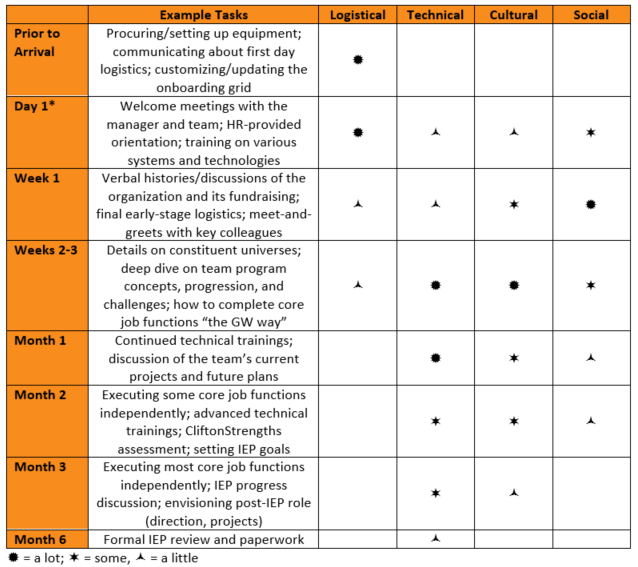Leadership
Willkommen, Bienvenue, Welcome, C'mon In: Onboarding for Success and Retention
By Catherine J. Flaatten, MPH | June 09, 2022
New employee turnover is becoming worryingly common: According to Work Institute’s 2020 Retention Report, up to 38% percent of new employees resign within their first year; of that figure, 66% leave within their first six months. The primary reasons cited for early departures are a lack of career development, low sense of well-being and unsatisfactory work-life balance. The last thing you or your organization wants is to lose all the time and resources that have been invested in hiring a new staff member less than a year later. Fortunately, supportive onboarding can help new employees want to stick around by:
- Defining success and providing quick access to the knowledge they need to achieve it.
- Engendering a sense of personal belonging and career direction.
- Affording opportunities for early wins that can boost their self-confidence and affirm their decision to join (and stay with) your team.
There are also special considerations for the importance of onboarding prospect development folks in particular. Many people in our industry are often introverted; we can feel less comfortable in large group settings and be drained more easily than extroverts by lots of interactions, a hallmark of the onboarding process. We also tend to be resourceful, independent and eager to produce, so we may be tempted to jump right in or expect others to do so, which skips important steps of the onboarding process. These same characteristics can inhibit critical onboarding delegation among managers. Well-tailored onboarding programs should acknowledge and accommodate these special considerations for prospect development professionals.
Core Elements and Structure
The core elements of onboarding can be described or categorized in myriad ways. A framework cited in the Harvard Business Review considers four broad categories:
- Logistical: Ensuring the employee has the basic equipment and access they need to get going.
- Technical: Describing what success looks like for the new employee in their role.
- Cultural: Explaining cultural norms of your team, the greater fundraising operation and the organization as a whole.
- Social: Providing structured social interactions to help the new hire forge relationships.
In my office, we structure our team’s onboarding plans by time period from their start date. The first few weeks are the most intensive for onboarding, pulling back gradually until the end of the six-month Introductory Employment Period (IEP):

From Day 1, we expect our new staff to drive their own onboarding — keeping themselves on pace, scheduling their own meetings, following up on items proactively and independently, designing how broadly/deeply to debrief with their manager at their weekly one-on-one meetings, etc.
This approach accomplishes several things. First, it tells the employee that the manager will support them with information and guidance, but also that they are being trusted to handle their own work — building trust in that relationship and shoring up the new hire’s self-confidence. Second, it reinforces the manager’s delegation skills, which are key to spreading out the heavy workload that comes with integrating a new staff member effectively. Third, it helps the new hire start building their own relationships outside of the direct manager relationship quickly by empowering them to start communicating, coordinating and socializing with their colleagues.
Assessment Framework
The following framework, adapted from the Harvard Business Review can be used to assess your current onboarding program’s strengths and weaknesses. In the article, the levels of onboarding support that a team or organization may provide are broken down into four distinct categories:
- Sink or Swim: The new hire is let into the building on their first day, and that is about it.
- Basic Orientation: The new employee gets some raw information about policies, structures, etc., but is left to make sense of everything on their own.
- Active Assimilation: The organization or team facilitates meetings for the new staff member with key stakeholders to generate a deeper understanding of the business and their role in it.
- Accelerated Integration: A customized onboarding experience that brings the new hire into strategic discussions, helps them identify and understand the challenges facing their business, empowers them to set goals to address these challenges and provides meaningful opportunities for collaboration and bonding with their colleagues.
To leverage this framework, start by listing out each critical task or competency in the first column of a grid, as in this example:

In this case, the task is proactive prospecting. The bullets outline some examples of what onboarding for this task might look like for each support category (skipping Sink or Swim, since that category does not entail any support). With each bullet worth one point, you can then add up the marks across the row to create an average score that reflects how well the current onboarding program is providing support for this particular competency. With a fully completed inventory of tasks, you can look:
- Row by row to see how well each competency is supported.
- Column by column to assess the average coverage of each support level, regardless of the task.
- Overall average of the whole assessment to estimate the condition of your onboarding program in its totality.
This exercise should help you celebrate and recommit to what you’re already doing well, identify gaps or areas needing deeper support, prioritize enhancements where your program is lacking most and track your progress over time.
Conclusion
A comprehensive and thoughtful onboarding experience is vital to every new hire’s success and retention. While an exciting time, onboarding can also be overwhelming for the new employee and the existing team — particularly if the organization’s onboarding process is lacking. With the additional pressures of the Great Reshuffle and the current mix of working environments in play (fully remote, in-person and hybrid), now is the optimal time to ensure your onboarding program is as supportive as possible for your new colleagues.


Catherine J. Flaatten, MPH
Managing Director of Research & Relationship Management, The George Washington University
Catherine is the Managing Director of Research & Relationship Management at The George Washington University. Setting the vision for the prospect development program within the division of Development and Alumni Relations, she leads her team in partnering with frontline fundraisers to reach new heights of success together. Previously, Catherine served as the Manager of Prospect Research at Share Our Strength, a national organization working to end childhood hunger in the United States. Prior to that, she worked in prospect research at the BrightFocus Foundation and the National Psoriasis Foundation.
A regular speaker and author within the local, national, and international prospect development communities, Catherine serves as President of Apra Metro DC and Chair of the AASP Best Practices in Prospect Development Committee. She holds a BA in International Affairs and an MPH in Maternal and Child Health, both from The George Washington University.